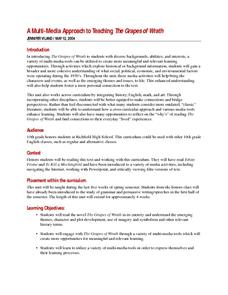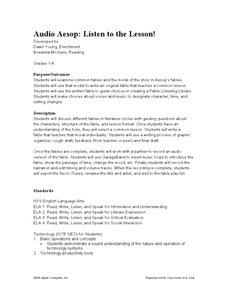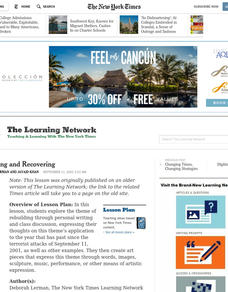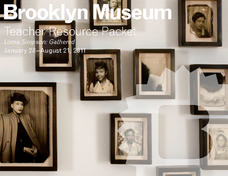Curated OER
Themes vs. Timelines
Teaching history through a thematic curriculum fosters a higher level of engagement and critical thinking in young historians.
Curated OER
Film Festival: Documentaries for Hispanic Heritage Month
In honor of Hispanic Heritage Month, the New York Times provides links to five short documentary films depicting Hispanic themes and culture. Learners can click on each embedded link to view the films, then answer each set of related...
Curated OER
Literary Criticism
Students evaluate and debate whether movies, television shows, and other mass media cause violent behavior in students and whether books are the same as or different from these other media in their potential for causing violent behavior...
Curated OER
A Multi-Media Approach to Teaching The Grapes of Wrath
Integrate history, math, and art into a study of The Grapes of Wrath with a series of activities that ask learners to investigate the social, political, economic, and environmental factors at play during the 1930s. Designed to be used...
Curated OER
Teaching About Genocide
Students can find that genocide is a prevalent theme in world history.
Curated OER
Audio Aesop: Listen to the Lesson!
Aesop's Fables are the focus of this language arts lesson plan. Young philosophers study and discuss the morals found in the most famous of Aesop's Fables. They write an original fable that teaches a common moral. A "Fable Listening...
Curated OER
Using Literature to Teach Bullying
Learners explore signs and types of bullying. In this "building character" lesson, students listen to several read alouds based on a bully theme. Four groups are formed to discuss "gossip", "exclusion", "physical bullying", and "verbal...
Museum of the Moving Image
Political Ads in Historical Context
Campaign ads target both timely issues and general themes. Presidential campaign ads from 1952 and 1988 provide class members an opportunity to compare how the topics ads choose to address can dramatically influence election outcomes.
Annenberg Foundation
Exploring Borderlands
What motivated Europeans to explore the New World, and what effects did their exploration have on Native American populations? The second installment of a 16-part American Passages series prompts pupils to watch a video and read several...
New York City Department of Education
Colonial America and The American Revolution
How did the founding of the American colonies lead to a revolution? Use the essential question and sample activities to guide learners through a series of history lessons. Additionally, the packet includes effective strategies to...
Facing History and Ourselves
Do You Take the Oath?
Why did so many go along with Nazi policies during World War II? An investigatory unit includes four handouts, reading analyses, classroom discussion topics, and intriguing philosophical questions, helping learners understand the...
Curated OER
Rebuilding and Recovering
What does it mean to rebuild and recover after a major event? Your class will explore this theme while they discuss and discover the events surrounding September 11. They will also look at other examples and then create art pieces that...
Brooklyn Museum
Lorna Simpson: Gathered
Lorna Simpson is a photographer who has put together a collection of photos from the 1950s in order to challenge the idea that primary source documents are objective in their portrayal of history. Learners are introduced to Ms. Simpson's...
Curated OER
Active Citizenship
Students think critically and then present the information they have researched about the government.
Curated OER
Teaching with Timelines
Students create illustrated timelines to accompany the historical events and people they have studied. In this chronological history lesson, students collaborate to create timelines that are enhanced with each new historical era...
Curated OER
It's Mine Lesson Plan
Students read a book called It's Mine! For this lesson about three frogs and sharing, students explore how what they do affects everything around them. Through a series of seven different activities, students interpret the frogs and...
Curated OER
Perseverance: Keep Going
Kids evaluate world history events that show perseverance by creating artistic images. They investigate historic photographs and images which conjure up the feelings of perseverance, then utilize acrylic paints to capture the...
Curated OER
Using Political Cartoons and Propaganda in Teaching the Holocaust
Students gain an understanding of the Holocaust through analysis of political cartoons. In this Holocaust lesson, students examine propaganda in political cartoons that were used in Nazi Germany.
Mr. Roughton
CSI: Florence
Who done it? Class groups adopt the role of crime scene investigators and examine exhibits (primary source documents) to determine who attempted to assassinate the members of the Medici dynasty.
Curated OER
Looking at Life through the Creation of Personal Metaphors
Learners focus on the creation of personal metaphors, which are first illustrated in pictures and caricatures and then extended to descriptive/analytical paragraphs. They teach the lesson to others using their own personal metaphors as...
Curated OER
Old Hickories
Learners analyze historical events to develop a historical perspective. In this critical analysis lesson plan, students read excerpts, primary sources and other materials in order to understand the Native American Removal that occurred...
Curated OER
Making The Holidays Special
Students examine ways in which holiday television specials reflect some of the religious, historic and cultural themes of the holidays on which they focus. They create their own holiday television specials in groups, each focusing on a...
Curated OER
Choose Your Path
Students identify the plot and theme of cartoons. In groups, they discuss and compare the written and movie versions of popular fairy tales. Individually, they write their own fairy tale and share them with the class. They write their...
Curated OER
Greco-Roman Origin Myths
Students explore myths that explain the world, recognize some characters of Greco-Roman mythology and their symbols, and Make personal connections to the theme by writing and drawing a myth of their own.























